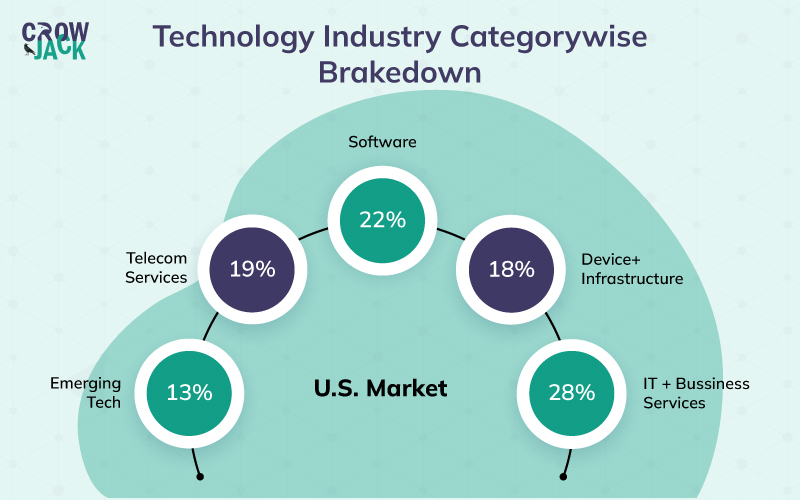Microsoft Overview
Microsoft is certainly among the most popular business corporations globally, with its operations spread across more than 100 nations. Microsoft is one of the leading technology and consumer electronics companies in the world offering high-end personal computers and unparalleled software, desktop operating, and cloud computing services. Another stand-out feature of Microsoft’s success story is the excellent leadership of Bill Gates, one of the world’s most successful business leaders.
Besides, with a market capitalization of almost 2 trillion, Microsoft is the third largest and most valued company in the world. However, in order to sustain its success in the long term, it is essential for the company to recognize the opportunities and threats prevailing in the external business environment. For that, PESTLE is the most effective strategic analysis tool that offers a holistic evaluation of the external environment.
This article presents an elaborated Microsoft PESTLE analysis. In case, you want to learn about PESTLE Analysis in detail, you can go through our exclusive PESTLE Analysis. As of now, let us get started with the PESTLE Analysis of Microsoft.
Table of Contents
An astute PESTLE analysis of Microsoft
Political factors affecting Microsoft
Political stability has a great impact on the smooth operations of the companies and the US has a highly stable political environment. The US has a great environment for the software industry as the taxation policies are very much in favor of the industry and the software companies are just taxed in 17 states and the income is exempted in the rest of the states. Further, the software industry has to enter into a large number of complex contracts and requires continuous maintenance of its products and services. The software maintenance contracts are also tax exempted in just 26 states, hence the companies can expect a lot of savings while conducting business in the country.
Besides, India is another important market for the software industry being one of the fastest emerging economies in the world. The trade relations between the US and India are favorable for the industry and the cooperation between the two countries is expected to get even better in the near future. Trade and investment bilateral agreements between the two countries present a highly favorable scenario for the software industry. Also, as per the Indian FDI policy, the Indian government allows 100 percent foreign direct investment in the software sector.
Economic factors affecting Microsoft
The growth rate of the US was 5.7% and is expected to be 4% in 2022 and 2.6% in 2023 (Shalal and Lawder, 2022). The businesses would have uncertainties in mind for making investments because of the high fluctuation which would ultimately impact the sales of the software companies. Further, in the last 1 year, there has been an increase in the wages and salaries by about 4.5% (Furman & Powell, 2022). This means that the cost of operations for the companies would also rise because of which they would be forced to raise the price of their software which can force the customers to change their buying patterns, ultimately impacting the sales of the companies.
Furthermore, in India businesses spend enormous amounts of money on cybersecurity and the overall corporate industry spent around $3 billion in 2021 and the growth of the cybersecurity market has almost doubled from $4.3 billion in 2019 to $8.5 billion in 2021, thus signifying a huge scope for the software industry.
The software industry in the US is currently worth $313.70 billion and is projected to reach and is predicted to rise to $733 billion by 2028 at a CAGR of 24.3%. Besides, the software market in India is expected to grow at a CAGR of 11.6 percent by 2025. Hence, the scenario for the leading software and technology companies is favorable to further acquire more customers in India. Further, in the US, the market for public cloud computing services is expected to reach USD 323 billion by 2026 growing at a CAGR of 11.9 percent as per Statista.
A category-wise breakdown of the US technology market for 2022 is illustrated in the graphic below.

Social factors affecting Microsoft
COVID has had a large impact on businesses in the US and around 22% of businesses have been shut down because of the high losses and the situation is not expected to improve in the near term. This could have a long-term impact on the sales of the software (Fairlie, 2021). But the high digital literacy rate of 84% among the community members can be a positive sign as this would increase the demand for a variety of innovative technology and software. Further, due to COVID, around 60% of the workforce is working from home. This can be a great opportunity for tech and software companies as the reliance on the same will increase with a boom in remote work. Hence this could have a positive impact on the demand for software and tech companies (Statista, 2022).
Besides, Indian businesses are fastly moving towards digitization. This can present a significant opportunity for software companies to enhance their footprint. Moreover, the rapid scale of innovation in the business world poses a great opportunity for the software industry. Indians are increasingly becoming tech-savvy and India also has the youngest population in the world which can again be a great opportunity for the tech and software industry.
Technological factors affecting Microsoft
The US government promotes innovation on a large scale and to boost the research in the country, the US government spent $157 billion on research in the technology in 2021. Various technologies that have emerged in the software industry include the use of artificial intelligence on the large scale for various operations. Further, the UI/UX is gaining more popularity and it has led to an increase in user interface quality and overall experience.
In addition, the new trend of serverless computing is evolving which has led to fewer infrastructure requirements for software development and faster development cycles. Another technology that is being used widely is the tools related to cybersecurity because of increasing cyber threats. The increase in cyber threats can be a positive opportunity for software companies to market their cybersecurity tools. Further, the use of cloud computing for storing data has eased the problems of businesses related to data management.
Further, the emerging technologies in the tech and software industry include edge computing, quantum computing, 5G, blockchain, IoT, Robotic Process Automation, and so on.
Legal factors affecting Microsoft
Laws such as The Sherman Act 1872 wherein it is prohibited to form a cartel and fix prices or create a monopoly govern the software industry. Further, the Privacy Act 1974 regulates the collection, storage, and use of data by software companies (Department of Justice, 2022). The intellectual property regulations allow businesses to innovate and register their patents for 20 years.
The other laws that govern the software industry include General Data Protection Regulation wherein the companies are required to maintain the confidentiality of the data obtained from the customers and the software companies are responsible for ensuring that their third-party vendors also comply with the norms.
In addition, the IT companies process most of the payments online so they are also covered under Payment Card Industry Data Security Standard which contains the information related to securing data and preventing financial fraud.
Besides, India is also one of the promising markets for the software industry nut however the recent government regulations state that the companies can only bid for any government tender if there is a local value addition to the tune of 20%-50%. As it is difficult to ascertain the local or foreign value of the software components, hence the companies would find it difficult to procure the government contracts (The Economic Times, 2021). This may limit the profitability of the software companies looking to expand their operations in India.
Environmental factors affecting Microsoft
Both the US and India are signatories to the International Paris Agreement and as a result, the US government has set a target to cut down the carbon emissions by 50% by 2030 (White House, 2021). Moreover, the federal government in India has decided to cut emissions fully by 2070. The software industry contributes hugely to the total greenhouse gas emissions through data centers.
Because of the government target, the industry would have to search for innovative means to design software, including leveraging Top Interior Design Software, and operate their data centers.
In the end, it can be concluded that the software industry has the great potential to enhance its profitability because of various reasons, firstly the digital workspace is poised to grow in the future which would not be able to sustain without effective software and then the businesses are demanding for hi-tech security products for which the companies must launch advanced solutions.
However, the software companies should minimize the negative impact of the operations by establishing environment-friendly data centers.
To conclude, overall, the political, technological, and economic scenarios are quite favorable for the tech, software, and cloud computing companies to further expand their business operations and acquire new customers. This could be a positive and promising development for Microsoft. However, increasing cyber threats can be a concerning issue for the company which needs to be addressed. Also, the industry will have to comply with the increasing number of legal and environmental norms for viable long-term success. Further, to assess the internal strengths and weaknesses of the company, you can go through our meticulous SWOT Analysis of Microsoft.
Recommended Readings
References
Furman, J., & Powell III, W. (2022). US wages grew at the fastest pace in decades in 2021, but prices grew even more. Retrieved 19 April 2022, from https://www.piie.com/blogs/realtime-economic-issues-watch/us-wages-grew-fastest-pace-decades-2021-prices-grew-even-more#:~:text=Since%20December%20of%202020%2C%20nominal,above%20their%20pre%2Dpandemic%20trend.
Menon, S. (2021). Climate change: What emission cuts have India promised?. Retrieved 19 April 2022, from https://www.bbc.com/news/world-asia-india-58922398#:~:text=Prime%20Minister%20Narendra%20Modi%20has,deadline%20than%20many%20other%20countries.
The Economic Times. (2021). Software, cloud firms urge govt to change criteria for contracts. Retrieved 19 April 2022, from https://economictimes.indiatimes.com/tech/newsletters/morning-dispatch/software-firms-want-new-rules-for-govt-contracts/articleshow/85255181.cms?from=mdr
Wickramasinghe, S. (2021). Today’s Top Trends in Software Development. Retrieved 11 April 2022, from https://www.bmc.com/blogs/software-app-development-trends/
Winn, P., & Stokes, K. (2021). PRIVACY ACT OF 1974. Retrieved 11 April 2022, from https://www.justice.gov/opcl/privacy-act-1974

 Proof Reading
Proof Reading  Copy Writing
Copy Writing  Resume Writing
Resume Writing  Blogs
Blogs Guides
Guides SOP's
SOP's Student Resources
Student Resources Research Topics
Research Topics Login
Login Register
Register



